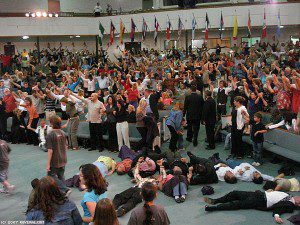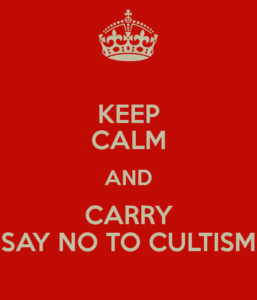 While I was away from a computer for a few days in Scotland, I found myself reflecting on a topic that many of us have considered – the Toronto Blessing. For those too young to remember this significant episode in the life of the Church, the Toronto Blessing was an episode of high-octane religiosity which spilled out from Canada in the 90s to affect many Christians in other parts of the world. Even those who were not caught up directly in this explosion of Pentecostal/Charismatic enthusiasm were aware of what was going on. Reactions varied from ‘this is a new outpouring of the Holy Spirit’ to ‘what a terrible example this is of religious hysteria.’ Few people who knew anything about it could remain totally indifferent. For myself the ‘Blessing’ peaked at around the time I was finishing off some writing I was doing on healing. The reports were such that I considered taking a plane to Toronto Airport to see what the fuss was all about. But having studied the phenomena that is Toronto subsequently, I am glad that I did not make the journey and submit my emotions and my psyche to a full-frontal assault.
While I was away from a computer for a few days in Scotland, I found myself reflecting on a topic that many of us have considered – the Toronto Blessing. For those too young to remember this significant episode in the life of the Church, the Toronto Blessing was an episode of high-octane religiosity which spilled out from Canada in the 90s to affect many Christians in other parts of the world. Even those who were not caught up directly in this explosion of Pentecostal/Charismatic enthusiasm were aware of what was going on. Reactions varied from ‘this is a new outpouring of the Holy Spirit’ to ‘what a terrible example this is of religious hysteria.’ Few people who knew anything about it could remain totally indifferent. For myself the ‘Blessing’ peaked at around the time I was finishing off some writing I was doing on healing. The reports were such that I considered taking a plane to Toronto Airport to see what the fuss was all about. But having studied the phenomena that is Toronto subsequently, I am glad that I did not make the journey and submit my emotions and my psyche to a full-frontal assault.
I have recently encountered a doctorate thesis on-line on the topic of the Blessing written by a South African, Stephanus Pretorius , from 2002. It is a very careful study. Its value for me is in the way that the author explores many disciplines in attempting to make sense of what went on at the small Airport church in Toronto for most of 1994 into early 1995. I am especially grateful for the attempt by the author to locate the phenomena of the Blessing within the context of world religion.
Among the reported effects at Toronto was the sight of people collapsing to the floor and lying apparently unconscious for considerable periods of time. Others were said to imitate animals either in their movements or in the sounds they made. The thesis claims that similar phenomena occur in Hindu spiritual practice, particularly in the disciplines associated with the awakening of an energy known as Kundalini. Kundalini is understood to be a primal energy living within every human being. It is the task of yogic spiritual practice to awaken this energy so that it can transform the body and raise it to its true potential. Kundalini energy is pictured as being like a snake at the base of the spine, waiting the opportunity to be awoken and activated in the spiritual seeker. The literature suggests that this life force also on occasion expresses itself in ways comparable to the Toronto phenomena.
That there should be a parallel between Toronto spirituality and a branch of Eastern yogic practice is something that many might find threatening to their understanding of the Christian faith. I personally do not find this idea strange as it has always been clear to me that God can only reveal himself using the faculties of mind and body that we all possess as humans. There are no special new organs of spiritual communication afforded only to Christians. A further point that is also striking in the thesis are the comparisons made between the pastors at Toronto and the gurus who teach kundalini practice. In both cases, a ritual of light touch by the leader is given when the disciple is considered ready. The Toronto initiate frequently falls to the floor and similar happenings may take place in a Hindu setting.
I suggested above that I am glad that I was not tempted to make the ‘pilgrimage’ to Toronto as part of my then research on healing. I mentioned that the highly charged atmosphere that was part of the daily service in the church seems to have been a bit like an assault on the spirit and psyche. Enormous energy was present in the building and however one wants to describe it, it is clear that few people were able to resist the massive primal emotion that was causing people to behave in strange ways. Such emotion and power seem potentially destabilising or even dangerous to mental well-being.
Pretorius’s thesis is particularly useful in the way that he discusses the power of hypnosis in the whole process. He sets out the characteristics of hypnosis for his reader. He notes the following.
1. Hypnosis is not a dreamlike quality. It is in fact a state where reflexes are fully functioning, alertness maintained and there is full awareness of what is going on.
2. The normal planning functions of a hypnotised person are reduced and the hypnotised person tends to wait passively for instructions from the hypnotist.
3. The subject’s attention becomes highly selective.
4. Role playing is readily accomplished, the hypnotised person frequently becoming quite thoroughly immersed in a suggested role.
It is clear from what Pretorius says about the state of hypnosis (he says a great deal more) that it can account for much of the strangeness of Toronto type events. It is also not difficult to identify how the participants were drawn into this state of hypnosis. The use of repeating choruses is a well-known technique for dulling the critical mind and inducing a trance-like state. I have frequently made the point that music has the capacity to bypass the conscious mind whether for good or ill. A further method used at Toronto to induce the state of hypnotic suggestibility (and no doubt among its contemporary imitators) is the repetition of suggestive phrases like ‘Let the Spirit come’ or ‘Flow into your hearts’. Taking this pragmatic understanding of hypnotic methods that we have, we need find nothing extraordinary in the spiritual events that are recorded as happening at Toronto.
Although what I have written above may seem to be reductionist and designed to undermine the Toronto experience, it is not meant to do this. The value of Toronto must be judged, not on its strangeness or its mechanics but on its fruits. Did the experience of Toronto change the hearts and lives of those attending, or did they experience a primal experience of disinhibition which they enjoyed and want endlessly repeated? For myself a suggestion that any Christian experience can only be enjoyed after using the methods of hypnotic suggestion and crowd psychology is one that makes me a little uncomfortable. My ongoing evaluation of Toronto will, however, not be swayed by what I think about the methods used to induce the experience. I shall be judging it by looking at the transformation that may have touched those who attended. The jury in me is still out.





